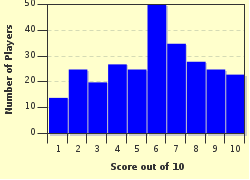Quiz Answer Key and Fun Facts
1. Which of the following is NOT a requirement for castling?
2. Which of the following would be the best trade-off points-wise?
3. In which of these situations is checkmate impossible?
4. When underpromotion occurs (i.e. promotion to anything other than a queen), which piece is the pawn usually promoted to?
5. One of the following moves is illegal. Which one?
6. In what century was the rule 'en passant' added?
7. How many moves (from each side) does the quickest possible checkmate take?
8. Which piece is not capable of reaching every square on the board?
9. Which of the following is not possible in the course of a chess game?
10. How many types of pieces are capable of moving one place to the left?
Source: Author
MntT77
This quiz was reviewed by FunTrivia editor
ozzz2002 before going online.
Any errors found in FunTrivia content are routinely corrected through our feedback system.


